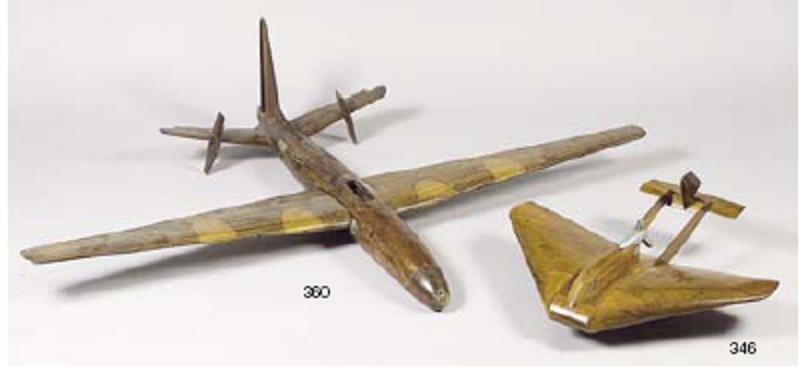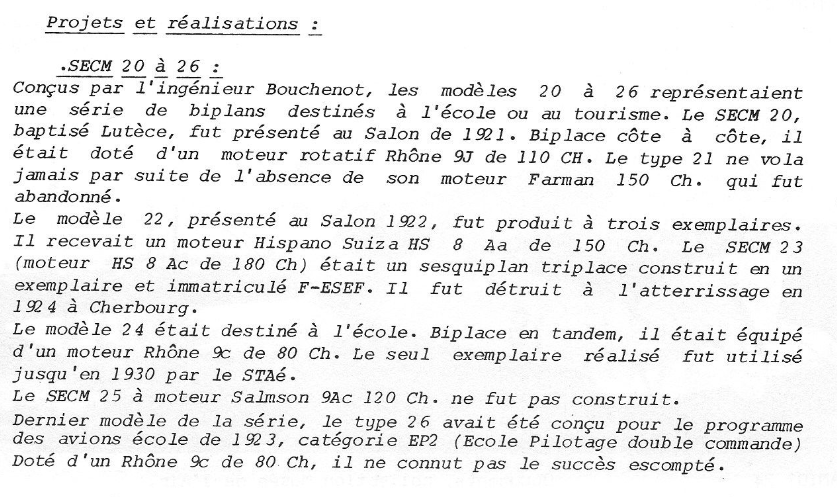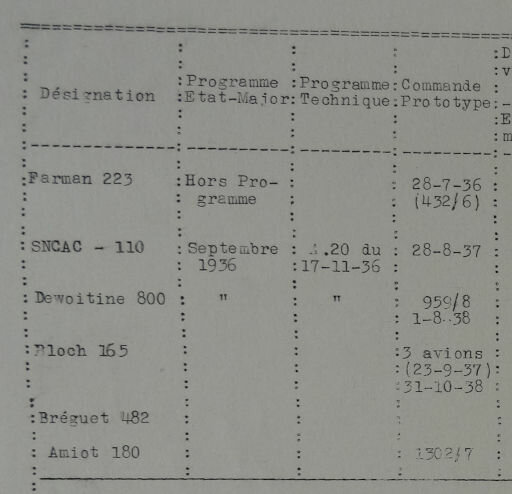You are using an out of date browser. It may not display this or other websites correctly.
You should upgrade or use an alternative browser.
You should upgrade or use an alternative browser.
SECM/Amiot Designations
- Thread starter Apophenia
- Start date
- Joined
- 26 May 2006
- Messages
- 34,894
- Reaction score
- 15,759
I think they meant this one,the Model on the right ?.SECM 540 was just a wing design
Attachments
- Joined
- 25 July 2007
- Messages
- 4,299
- Reaction score
- 4,196
Via my dear Tophe,and from TU 128.
______________________________________Projects and achievements:
SECM 20 to 26:
Designed by engineer Bouchenot, models 20 to 26 represented a series of biplanes intended for school or touring. The SECM 20, baptized Lutèce, was presented at the 1921 Salon. A side-by-side two-seater, it was fitted with a 110 hp Rhone 9J rotary engine. The type 21 never flew due to the absence of its 150 hp Farman engine, development of which was abandoned.
The model 22, presented at the 1922 Salon, was produced in three copies. It received a 150 hp Hispano Suiza HS 8As engine. The SECM 23 (180 hp HS 8Ac engine) was a three-seat sesquiplane. One example was built and registered F-ESEF. The SECM 23 destroyed in a Cherbourg landing accident in 1924.
The model 24 was intended for training. A tandem-set biplane, it was equipped with a Rhône 9c engine of 80 hp. The example produced was used until 1930 by the STAé.
The SECM 25, intended to be powered by a Salmson 9Ac 120 hp engine, was not built.
The last model of the series, the type 26, had been designed to a 1923 school training the program - category EP2 (École Pilotage double commande). Endowed with an 80 hp Rhône 9c, the type 26 was not a successful candidate.
Thanks hesham ... details added.
- Joined
- 26 May 2006
- Messages
- 34,894
- Reaction score
- 15,759
As in reply # 29,it was just a float seaplane version of Amiot-120.120S was a seaplane or flying boat Project,maybe developed from Type-110S ?
- Joined
- 25 July 2007
- Messages
- 4,299
- Reaction score
- 4,196
As in reply # 29,it was just a float seaplane version of Amiot-120.120S was a seaplane or flying boat Project,maybe developed from Type-110S ?
The SECM 120 S (Spécial) is described in the clipping in reply #29 as "Raid". So, a long-distance record attempt aircraft. Photos of the 120S (modified 120-02 prototype) show it on the usual wheeled land undercarriage. So, not a floatplane variant.
- Joined
- 26 May 2006
- Messages
- 34,894
- Reaction score
- 15,759
Unknown was early 1939 design of seaplane, transatlantic, with 8 diesel engines CLM Junkers of
500 hp coupled 2 by 2 and driving contra-rotating propellers
We forget this Project.
I think that was Amiot-390,if we look to the date,it was only Project came between Amiot-380
and Amiot-400 ?.
- Joined
- 25 July 2007
- Messages
- 4,299
- Reaction score
- 4,196
Perhaps, but we have no non-circumstantial evidence to back that up.
Odd about those "CLM Junkers of 500 hp". Were these a coupled version of the CLM Lille 6As (licensed Jumo 205)? If so, that engine produced 650 hp back in August 1936 when the Bernard 86 was fitted with that diesel. Did CLM Lille really need to derate this engine for coupling three years later?
Odd about those "CLM Junkers of 500 hp". Were these a coupled version of the CLM Lille 6As (licensed Jumo 205)? If so, that engine produced 650 hp back in August 1936 when the Bernard 86 was fitted with that diesel. Did CLM Lille really need to derate this engine for coupling three years later?
Holger Loersch
ACCESS: Restricted
- Joined
- 7 October 2019
- Messages
- 3
- Reaction score
- 6
Hello from Germany,
I've just discovered in the issues of JAWA's 1928-1930, the Amiot 101 C1 Single-Seat fighter. This a/c is in most other publications the Amiot 110 C1. But why should they use the same number for completely different aircraft (Amiot 110 C1 Fighter, Amiot 110 S Seaplane).
Could that be possible, that Jane's did the same mistake for a wrong number for 3 years?
I've just discovered in the issues of JAWA's 1928-1930, the Amiot 101 C1 Single-Seat fighter. This a/c is in most other publications the Amiot 110 C1. But why should they use the same number for completely different aircraft (Amiot 110 C1 Fighter, Amiot 110 S Seaplane).
Could that be possible, that Jane's did the same mistake for a wrong number for 3 years?
Attachments
- Joined
- 26 May 2006
- Messages
- 34,894
- Reaction score
- 15,759
Hello from Germany,
I've just discovered in the issues of JAWA's 1928-1930, the Amiot 101 C1 Single-Seat fighter. This a/c is in most other publications the Amiot 110 C1. But why should they use the same number for completely different aircraft (Amiot 110 C1 Fighter, Amiot 110 S Seaplane).
Could that be possible, that Jane's did the same mistake for a wrong number for 3 years?
You will see more details in my book with Mr. Jamesw Davilla about
French Military Aircraft 1919-1945.
- Joined
- 26 May 2006
- Messages
- 34,894
- Reaction score
- 15,759
From Aviation magazine 1962.
A mystery,it was Amiot-364 ?!.
- Joined
- 25 July 2007
- Messages
- 4,299
- Reaction score
- 4,196
A mystery,it was Amiot-364 ?!.
Could be. The use of R-1830C engines strongly suggests a prewar concept.
- Joined
- 25 June 2009
- Messages
- 14,752
- Reaction score
- 6,141
This mention under the Amiot 143 entry is erroneous, as there was not "Amiot 132". You were referring to the Amiot 142 M4.- Original order was for Amiot 132 M4 variant
- Joined
- 26 May 2006
- Messages
- 34,894
- Reaction score
- 15,759
- 148: (??) hypothetical designation
In my new book,you'll find it was a real design.
- Joined
- 25 June 2009
- Messages
- 14,752
- Reaction score
- 6,141
- Joined
- 26 May 2006
- Messages
- 34,894
- Reaction score
- 15,759
Very great work,
and I want to explain how there are many arrangements of this designer,and
how he made many re-allocations to the series,it's very complicated;
- When he began from his company, Type X (later type 100),XI,XII (later type 120),XIII & XIV.
- Then started from 1923 to 26,Type 100,110,120,130 ?,140T,150T,160T & 170T.
- By 1927 to 1934; Type 110,120 (not used,because the Amiot-120 still there),130,
140s,140T,150,160T,170,180,190 & 200
- from 1934 and up to end,there is two different sequences;
A- Type 150,160 & 170
B- Type 200 to 300,310,320,330,340s,350s,360,360/II,370s,380s,390,400s,410,
410/II,410/III,420,430 raised to 530 and 540
and I want to explain how there are many arrangements of this designer,and
how he made many re-allocations to the series,it's very complicated;
- When he began from his company, Type X (later type 100),XI,XII (later type 120),XIII & XIV.
- Then started from 1923 to 26,Type 100,110,120,130 ?,140T,150T,160T & 170T.
- By 1927 to 1934; Type 110,120 (not used,because the Amiot-120 still there),130,
140s,140T,150,160T,170,180,190 & 200
- from 1934 and up to end,there is two different sequences;
A- Type 150,160 & 170
B- Type 200 to 300,310,320,330,340s,350s,360,360/II,370s,380s,390,400s,410,
410/II,410/III,420,430 raised to 530 and 540
- Joined
- 26 May 2006
- Messages
- 34,894
- Reaction score
- 15,759
My dear Apophenia,
please add Amiot-180/II of 1934 to the list after my proof to it,here;
please add Amiot-180/II of 1934 to the list after my proof to it,here;
- Joined
- 15 February 2024
- Messages
- 500
- Reaction score
- 1,302
I think this is just a mistake from Air Ministry: they wrote by error Amiot 180 for B5 instead of Amiot 380. I found some documents about Amiot 380 study under the same purchase order reference: 1302/7.My dear Apophenia,
please add Amiot-180/II of 1934 to the list after my proof to it,here;
In any case, your explanation is no more than an hypothesis, not a proof.
- Joined
- 26 May 2006
- Messages
- 34,894
- Reaction score
- 15,759
I think this is just a mistake from Air Ministry: they wrote by error Amiot 180 for B5 instead of Amiot 380. I found some documents about Amiot 380 study under the same purchase order reference: 1302/7.
In any case, your explanation is no more than an hypothesis, not a proof.
Amiot-380 was appeared in 1937/38,how come it had been belonged to 1934 competition ?.
- Joined
- 15 February 2024
- Messages
- 500
- Reaction score
- 1,302
The Amiot 180 is a BN5, derived from Amiot 143 with 4 engines, for TGP program (1930-1933).Amiot-380 was appeared in 1937/38,how come it had been belonged to 1934 competition ?.
The 1938 attached document lists the concurrents of A20 program fo B5 (1936-1938), not 1934. This is why I suspect that this is in fact the Amiot 380 (4-engine derived from Amiot 350) instead of Amiot 180.
Attachments
- Joined
- 26 May 2006
- Messages
- 34,894
- Reaction score
- 15,759
The Amiot 180 is a BN5, derived from Amiot 143 with 4 engines, for TGP program (1930-1933).
The 1938 attached document lists the concurrents of A20 program fo B5 (1936-1938), not 1934. This is why I suspect that this is in fact the Amiot 380 (4-engine derived from Amiot 350) instead of Amiot 180.
No need to rush,we don't have all Amiot documents ?!.
- Joined
- 26 May 2006
- Messages
- 34,894
- Reaction score
- 15,759
I think they meant this one,the Model on the right ?.
Those are two projects for Amiot,but they were not related to Amiot-540,
because it was just a wing configuration (not aircraft).
Similar threads
-
-
-
-
-
Arsenal de l'Aéronautique ("Arsenal") designations
- Started by Apophenia
- Replies: 26



